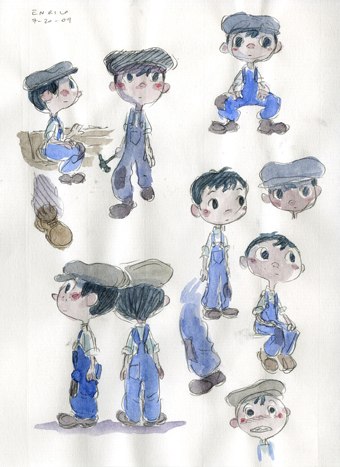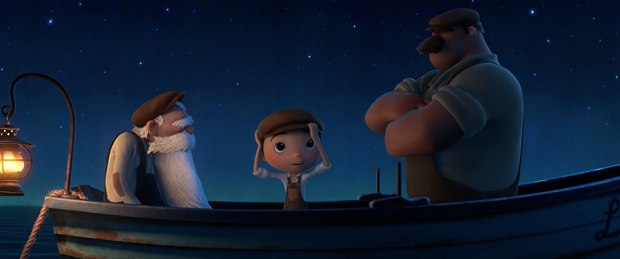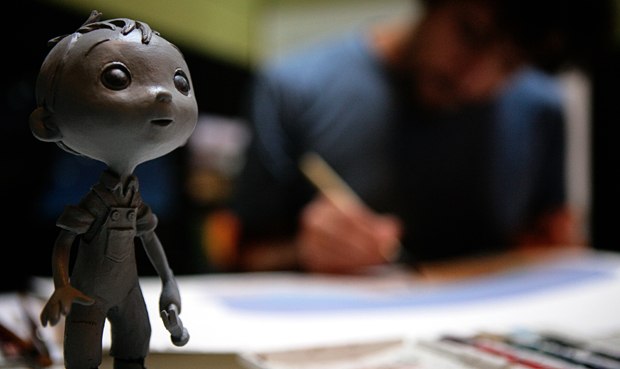Enrico Casarosa provides an exclusive sneak peek about his first Pixar short, premiering this week at Annecy.
Check out the La Luna clip at AWNtv!
It's fitting that we get multiple shorts this year in honor of Pixar's 25th anniversary (Gary Rydstrom's Hawaiian Vacation, which launches the Toy Story Toons brand, bows with Cars 2 on June 24; the second will play with The Muppets on Nov. 23). However, La Luna, the wistful coming of age fable, which debuts at Annecy this week, is the real Oscar contender. In fact, the lovely illumination motif harkens back to Luxo, Jr. Although it's not currently attached to a feature, the most likely prospect is next year's Brave (opening June 22). Prior to leaving for Annecy, Enrico Casarosa (who's been promoted to head of story after working on Cars, Ratatouille, Up and Cars 2) discussed his unique Italian-flavored short, in which a young boy who rows out to sea in an old wooden boat with his bickering Papa and Grandpa as they await some lunar adventure.
Bill Desowitz: What's the genesis of La Luna?
Enrico Casarosa: I've been working on the idea since 2008 and pitched it to John [Lasseter] at the beginning of 2009 and started it later that fall. The core idea has two parts: A personal story about me growing up by the sea in Genoa, and how my father and grandfather rarely speaking to one another. I can remember being 11 or 12 and getting caught in the middle at the dinner table with these very uncomfortable conversations. My grandfather lived with us, which probably had a lot to do with it.
BD: What were your influences?
EC: My biggest ones are The Little Prince and Miyazaki and his sense of the fantastic; there's also Italo Calvino's story, "The Distance of the Moon," about building a ladder to the moon. When I read that, I wanted to do a story like that and invent a myth about what happens up there. There's also La Linea by Osvaldo Cavandoli with lots of gibberish from the protagonist. I thought it would go well with Italian gesturing. So I came up with a coming of age story about a little boy stuck between these two personalities and finding his own way around a very strange and fantastic place. The setting felt right with these characters from the 1920s or '30, peasants or farmers or miners. I liked the juxtaposition.
BD: What was Lasseter's best advice?
EC: This should be the first day that this boy goes on this adventure and we experience this special day with the boy. John embraced the uniqueness of this and there was never talk of adding humor. He kept saying, "I want to be there!"
BD: At nearly 7 minutes, this is the longest Pixar theatrical short, isn't it?
EC: Yes, the shape of the story was very much there. It was a matter of sculpting it; we tightened it with everyone's help as we went along. The one element that got refined was the gibberish language that the grandfather and father speak. If anything, that was something that we had to slowly sell because it didn't sell immediately. We had to find our tone and not make it too annoying. They realized that a little gibberish goes a long way. And not everybody can do it, so it was also about finding the right performer. We had a helper in [John Gilkey] a clown with great gibberish from Cirque du Soleil, who was a consultant on Ratatouille. We called him in again and he was one of the first to help us.
BD: Some have remarked how the father resembles the character from Cloudy with aChance of Meatballs.
EC: It's purely accidental -- my inspiration was Miyazaki's miner from Castle in the Sky. The arguing is all with the father's moustache and the grandfather's beard. I thought I'd be saving time by not having mouths, but it didn't work out that way. The hair was very challenging. The animators needed the controls to give expression and the kind of vibration that suggests speech. There was a lot of back and forth between grooming and the animators.
BD: And the look of the boy? He reminds me of Boo.
EC: We wanted him to be completely open and round and all eyes like a light bulb. In fact, we had to pull back on the size of the eyes so he would look more like the father and the grandfather.
BD: It's all very painterly with watercolors and pastels. Talk about the look and the animation.
EC: I was after a graphic feel in reflections and the challenge was to find graphic shapes in the waves. We worked very closely with effects to find the right kind of waves to give us a feeling of depth and still very graphic. They're real reflections into the water of the moon, which is a watercolor that we painted. We tried to use as much real media right on the screen. All our backgrounds are real pastels that were done by Bill Cone, the La Luna production designer. The Milky Way is pastel; the sky is pastel. I wanted to keep it tactile and textured. It started with my watercolor image boards. The boat, for example, has watercolor planks that are mapped onto the model.
BD: What about the moon?
EC: We end up on the moon and the lighting changes radically, of course. Bill did wonderful pastels for the color script. We found a few tricky spots with change of perspective [in 3-D] where we have to feel how different the moon is from earth. The lighting team helped us achieve texture on the moon. For example, a lot of the glows around the moon are moving textures made by panning different watercolor papers with little particles of color. Glows are not uniform but textured gradients. There's nothing groundbreaking other than our wish to really use stuff that isn't computer-generated but that we brought into the computer from real materials. There's this wonderful quote from Lynda Barry [the cartoonist/novelist]: "In the digital age, we shouldn't forget to use our digits."
Bill Desowitz is senior editor of AWN & VFXWorld.











